The Serpent in the Sword:
Pattern-welding in Early Medieval Swords
by Lee A. Jones
From the time of its first appearance about 4,000 years ago, the sword
soon became the pre-eminent weapon of personal defense and has been a preferred
vehicle for technological and artistic expression even since its relatively
recent decline. Within what at first seems to be merely a simple variation
of that basic tool, the inclined plane, metallurgical studies have revealed
complex piled structures in iron swords dating from as early as Celtic times13 (500 BC).
Being composed of several rods welded together and running the length of
the blade, such piled structures allowed the smith to localize desired properties
by empirically joining together irons with differing properties owing to
different origins and concentrations of trace elements. Additionally, small
rods could be carburized to increase hardness by increasing carbon content.
Ideally, steel (which is an alloy of iron with small amounts of carbon)
would be chosen to provide hardness at the edge. However, since an increased
carbon content concomitantly causes brittleness, softer and more malleable
wrought iron or mild steel is better used for the remainder of the blade
in order to impart resistance to fracture. Piled construction provides another
advantage in that it averages the strengths and weaknesses of the individual
components.
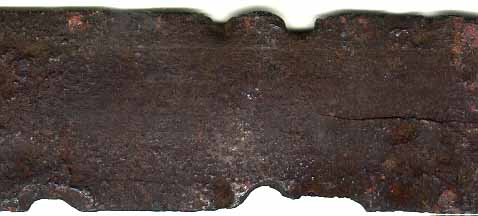
1. Detail of the blade of a Celtic
sword from the 1st century BC, in an area presumably bent prior to inhumation
and later straightened. Differential corrosion discloses separate elements
for the cutting edges and vague linearity parallel to the long axis suggests
piled construction. A parallel stress fracture is seen to the left and
may be along a welded boundary (Private collection).
In the pattern-welded sword blades made from the Migration Period through
the mid-Viking Age (5th through 10th centuries), swordsmiths manipulated
the piled structure of the blade to create a striking decorative effect.
Virtually all existing swords from these times are in excavated condition
and in many cases weak acidity in the earth or water has differentially
etched the blade surfaces and the presence of complex geometrical patterns
integral to the substance of these European sword blades has long been recognized;
the lithographs in the survey of Norwegian Viking swords in the Bergens
Museum by Lorange8
from 1889 remaining unsurpassed in their beauty and clarity. In the earlier
part of this century, some academics proposed impossibly complex explanations
of the "lost art" of forging these patterns, although the basic
techniques of pattern-welding had, in fact, on the factory floor, remained
in use into this century in the forms of Damascus shotgun barrels and in
Solingen's production of presentation grade sabers and daggers, including
those of the Third Reich14. Essentially identical pattern-welding techniques
are also commonly encountered in near-Eastern weapons such as yataghans,
kindjals and quaddaras as well as in Indonesian krises.
Herbert Maryon introduced the term pattern-welding in 1948 in conjunction
with a sword found near Ely and in 1960 published a detailed account of
the pattern-welding process9. J. W. Anstee1, Lena Thålin-Bergman15 and Jaap Ypey18, among others, have made further contributions
in this field, with the metallographic studies of R. F. Tylecote and B.
J. J. Gilmour16
and the radiographic studies of Janet Lang and Barry Ager6 being the most significant recent works.
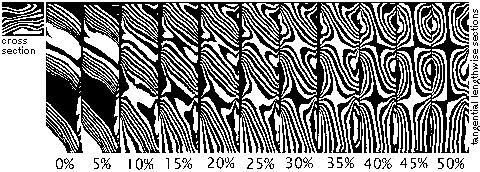
2. Patterns disclosed by successively
grinding a facet along the length of a twisted rod demonstrated in a clay
model of a rod composed of sixteen alternating layers prepared by bladesmith
Dan Maragni. The rod has been mildly squared and joined along side another
rod, shown only focally at the edge. The rod was progressively ground and
photographed at each interval, reduced in overall thickness by the percentage
shown in the scale below. Further leveling of the rod will reverse this
trend, as a mirror image of the patterns first disclosed.
Essentially all of the patterns identified in these weapons may be built
up from rods composed of several, frequently seven, alternating layers of
varyingly dissimilar irons (varying depending upon trace elements inherent
in the ores of origin) welded together. Depending upon the ultimate pattern
desired these rods would then be twisted either to the left or right or
allowed to remain straight along the length of the rod. Rods with matching
or complementary twist patterns are ultimately installed side-by-side into
the sword blade. Grinding away the outer surfaces of such rods discloses
a predictable evolution of patterns which may be further varied by flattening
of the rod before it becomes welded to its neighbors in the fabrication
of the central portion of a sword from several such rods. Figure 2 details
the evolution of the patterns as progressively more of the face of a twisted
rod is ground away, diagonal patterns of roughly parallel lines being from
the periphery of a rod and curved patterns coming from progressively deeper
sections until the middle is reached, at which point a square checkerboard
pattern emerges. Phosphorus rich iron, which remains lighter in color when
exposed to mildly acidic etching agents, was sometimes employed to increase
the contrast of the layers within a rod. Variations in carbon content also
play a role in the etched appearance and patterns will emerge to some degree
even when similar iron is used in all parts of the sword, owing to slag
inclusions and trace elements added by the flux used in welding. Nickel
alloys are most commonly employed to enhance contrast in modern work.
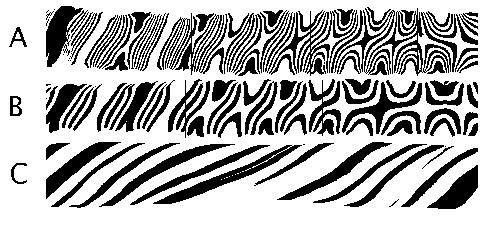
3. Pattern variations shown in
clay models prepared by bladesmith Dan Maragni. A. Successively ground,
left to right, twisted rod with sixteen layers. B. Successively ground,
left to right, twisted rod with eight layers. C. Twisted rod, subsequently
flattened. The pitch of the twists creates a pattern resembling that seen
in some of the Nydam swords.
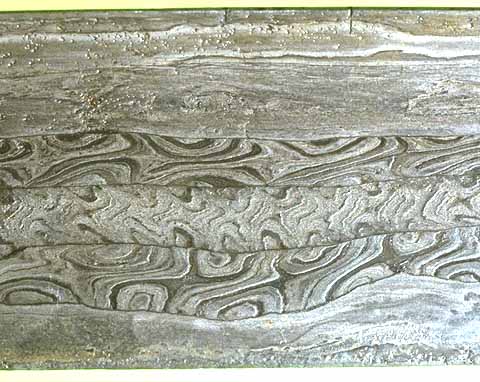
4. Detail of a yataghan blade,
probably 18th or 19th century, showing three bands of pattern welding,
exposed to varying depths generally between 25 and 50% of the rod thickness.
The blade is relatively thin except for a ridged back and differences in
the courses of the bands hint that there are three separate strips applied
to each side and that the pattern-welded rods may have been flattened considerably
(Private collection).
Radomir Pleiner's The Celtic Sword13 provides a comprehensive survey of early
ferrous swords and documents wide variations in blade construction and quality.
While Celtic smiths may not have used their materials effectively in many
of the blades Pleiner studied, he found that in just over fifty percent
of the swords steel was present in at least one cutting edge. While occasional
twisted strips are seen in the piled structures of swords dating from the
late La Tène period (1st century BC to 1st century AD), true pattern
welding becomes evident from about the 3rd century AD in swords from the
peat bogs at Nydam in northern Germany, reaches its zenith in terms of complexity
in the 6th and 7th centuries and is generally out of use by the end of the
10th century. Blades of the Migration Period (5th and 6th centuries) and
of the Vendel (or Merovingian) Period (7th and 8th centuries) average 71
to 81 cm. in length exclusive of the tang and between 4.3 and 6.4 cm. in
width, with the majority falling into the narrower end of the range and
not exceeding 5.6 cm. in width. The edges of these swords tend to be parallel
or with minimal taper towards a spatulate point. The faces of the blade
are often flat and the central flat portion is pattern-welded, with the
edges and tip being of non-patterned steel. The swords of the Viking Age
evolved from these with the average blade length remaining relatively constant
at about 78 to 81 cm. excluding the tang. A change in the overall shape
of the blade gradually occurred such that the degree of taper increased
slightly, bringing the balance point closer to the hilt. Also, the swords
became slightly heavier and a shallow fuller on each side of the blade became
increasingly pronounced during this time.
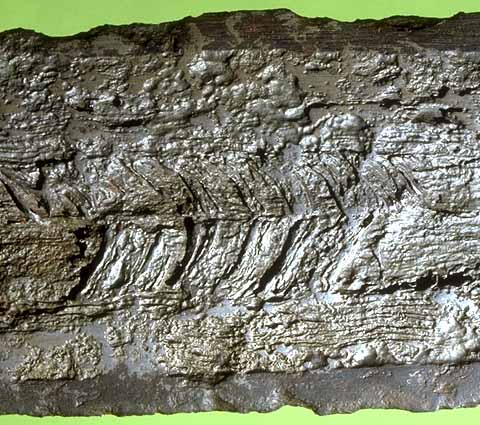
5. Detail of a winged spearhead,
9th century Carolingian type, showing remains of two thin bands of pattern
welding of diagonal form, forming a chevron, overlying a base of non-patterned
metal. Wide bands with relatively straight pattern are frequently thin,
suggesting much flattening of the rods (Private collection).
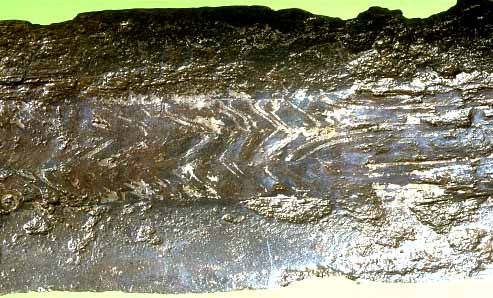
6. Detail of a double edged sword,
9th century. On the left, the center of the blade is made up of three twisted
bands, the center band twisted opposite to those beside it, forming a herringbone
pattern. On the right, all three bands straighten. Along the entire 74
cm. length of this blade, there are seven such alternations on each side
with straight areas opposite the twisted areas on the other side of the
blade, indicating that the central patterned area is made up of at least
six rods (Private collection).
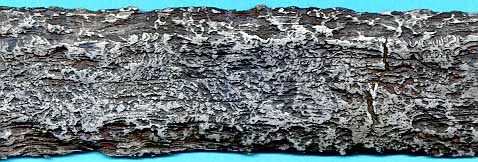
7. Detail of a double edged sword,
8th to 9th century. The central portion of the blade is composed of four
bands of pattern-welding and shows straight areas alternating with pattern
consistent with being from the center of the rod. As areas of corrosion
not pictured disclose a central plain core, the blade contains a total
of eight patterned strips. To the right of the center, perpendicular to
the long axis a stress crack is seen crossing the bands; the other layers
of the blade appear to have better withstood the stress (Private collection).
Pattern-welding in these swords usually consists of two to four bands
in the central flat or fullered face of the blade running from the base
of the blade adjacent to the hilt to within a few cm. of the tip. Many swords
show complicated patterns of twisted bands alternating with straight areas,
and almost every imaginable combination can be found in the archaeological
material. The pattern disclosed by radiography of the Sutton-Hoo sword is
that of four bands, alternatingly twisted and straight and with the direction
of twist reversed between adjacent bands and the entire pattern repeated
on the opposite surface of the blade except that the straight areas are
opposite the twisted on the other surface, and is a commonly seen pattern.
One of the swords published by Leppäaho7 from the National Museum in Helsinki (NM
2022), dated to the 8th century, displays numerous patterns, the plainer
side nearest the hilt showing three bands, each about 0.7 cm. in width having
diagonal twists characteristic of the peripheral section of a twisted rod
forming a herringbone (or chevron) appearance and alternating with straight
areas of non-twisted rods. The diagonal areas evolve into a curved pattern
characteristic of about 25% of the rod having been ground away in the mid
portion of the blade, beyond which the pattern rapidly transforms into two
bands, each 1 cm. in width, forming a checker-board pattern characteristic
of the center of a twisted rod for a few centimeters before again resuming
a curved pattern without the presence of alternating straight areas. The
pattern on the opposite surface of the blade begins as two bands of curved
pattern, each 1.3 cm. wide, adjacent to the tang. A zone of corrosion obscures
the pattern in a zone several centimeters from the tang, just beyond which
two inlaid iron strips perpendicular to the length of the blade and covering
the fuller are seen. Beyond this, three bands of diagonal (herringbone)
pattern alternate with straight areas until the mid-portion of the blade,
where the central band lifts above its adjacent companions and transforms
into a wavy serpent-like inlay alternatingly covering the remaining two
bands and what appears to be an untwisted rod in between as it makes its
undulations approaching the tip.
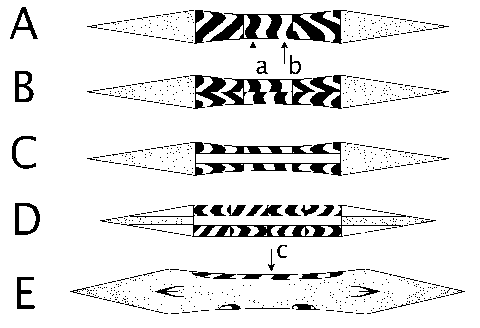
8. Cross-sectional diagrams of
typical sword blades from the Migration Period through the end of the Viking
Age. A. Blade with three pattern-welded rods as its core and with steel
edges; a. depicts low carbon iron and b. depicts contrasting iron frequently
containing phosphorus in order to enhance pattern clarity. B. Blade with
core composed of six pattern-welded rods; intermediates between A. &
B. have been documented to exist16. C. Blade with three bands of pattern-welding
on each side, separated by an iron core; this construction pattern is very
commonly encountered. D. Blade with four bands of pattern-welding on each
side, an iron core, and separate steel rods for the edges. Metallographic
studies frequently show the edge sections to also be of complex composite
structure16.
E. Representation of an ULFBERHT style blade, after Williams17, which is
built up from a complex piled structure, with steel in the edges and the
lowest carbon concentrations at the core. The small c. depicts vestigial
pattern welding, being a thin inlay forming the smith's name or geometric
patterns.
Just as many variations are seen upon the surfaces of these blades, cross-sections
are also quite variable throughout the period. Blades with one layer of
pattern-welding, visible from both sides, appear to be less common than
blades with two layers (one on each face) or with a further central layer
of plain ferrous metal as a core in between which may well represent the
most common pattern. Swords having some full thickness bands side by side
with bands making up only half of the thickness are also known. Lang and
Ager discovered that the curving patterns were rare in the British material,
suggesting that the fullers were forged in Britain instead of being ground
out as specimens from the remainder of Europe suggest. Many authors conclude
that twisting of rods may have excluded slag, allowed a higher carbon content
throughout (when the rods were carburized) and distributed strength and
weakness throughout in a manner analogous to modern plywood, allowing stronger
swords than would have otherwise resulted. Late pattern-welded blades from
the continent may have a thin veneer of pattern welding over a more homogeneous
iron core, suggesting that, while pattern-welding may have evolved as a
consequence of the piled structure seen in the Celtic sword, in the end
it was a decorative process.
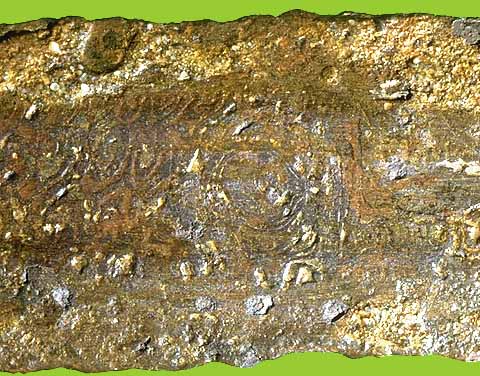
8a. Detail of a double edged
sword blade found in the Netherlands showing background curved patterns
on the left, consistent with a plane of section nearing the centers of
the composing rods, and having a central circular overlay in iron, to the
right of which is another overlay perpendicular to and overlying the fuller;
probably 8th or 9th century. (Private collection).
That these patterns were visible as the swords were finished in antiquity
is evident from the acknowledgment concerning a gift including swords which
Theodoric's Roman secretary Cassiodorus wrote to the Varni, a northern Germanic
tribe, in A.D 520 praising the interplay of shadows and colors in the fullers
of highly polished blades, likening the pattern to tiny snakes3,10. Kormák's Saga, dating to the 10th
Century may well include a reference to pattern-welding in Skeggi's instructions
to Kormak concerning the use of the sword Sköfnung. "The management
of it may seem difficult to thee," said Skeggi, "a covering goes
with it and thou shall leave it quiet; the sun must not shine on the upper
guard, nor shall thou draw it except thou preparest to fight; but, if thou
comest to the fighting place, sit alone, and there draw it. Hold up the
blade and blow on it; then a small snake will creep from under the guard;
incline the blade and make it easy for it to creep back under the guard."4 While these
instructions are generally interpreted today as an attempt by the older
Skeggi to induce in Kormak some respect for the weapon and to temper his
impulsiveness, it is interesting to conjecture that the point of covering
the handle of the sword from the sun could have been to keep the sword cold
such that when the sword was drawn the condensation of breath upon its polished
surface would have highlighted any differences in the texture or material
of the blade giving the impression of a small snake creeping from under
the guard and then as the condensed moisture evaporates, returning. Many
other ancient references to these swords exist and are well documented in
the works of H. R. Ellis Davidson3 and Ewart Oakeshott.10,11


9. Detail of an +ULFBERHT+
inscription and geometric designs on the opposite face of the blade, 10th
century. Notice the patterns within the twisted rods used to form the inlay.
(Private collection).
Pattern-welded blades continued to be made at least into the early 10th
century, however, over the course of the 9th century, twisted iron inlays
forming letters, symbols and geometric designs came to predominate. Lang
and Ager's6
survey of the British material failed to disclose swords with both a pattern
welded structure and iron inlays, however such swords are not uncommon in
the continental material. The iron inlaid inscriptions may take the form
of names, ULFBERHT and INGELRII are the most common; the occasional
association of these names with the Latin ME FECIT indicating these
are maker's names. As these names remained in use for a couple of centuries
as inlays, they may better be regarded as trademarks intended to indicate
the workshop which produced the blade. The incredible degree of variations
in letter formation and spelling would suggest that if the trademark hypothesis
is correct, rampant counterfeiting prevailed. For the blades with inlaid
names, a geometric pattern is often seen on the opposite blade face. Inlays
of circles, lines and curved symbols are also commonly identified. The inlays,
hot forged into the surface of the blade, are often formed of twisted iron
wire similar to the rods which had formerly made up pattern-welding; phosphorus
rich iron again sometimes being employed to increase the contrast. By the
second half of the 11th century, the iron inlaid smith's name trademarks
and symbols have been replaced by iron inlaid inscriptions, often not pattern-welded,
and most commonly consisting of various corrupted spelling of IN NOMINE
DOMINI, equivalent to the modern "In the name of the Lord,"
probably not entirely coincidentally fitting for an era which saw the earliest
of the Crusades.
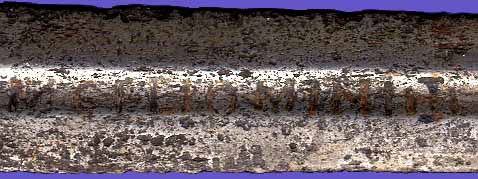
10. Detail of a the ending portion
of a variant of an IN NOMINE DOMINI inscription, 11th century; the inlaid
letters are not pattern-welded. (Private collection).
The author would like to thank Judy Gray, Fran Morano, Sylvia Oliver,
and Doug Whitman for their assistance in the production of the illustrations,
Dan Maragni for slaying many inaccuracies in the early drafts of this article
and for preparing the models of the twisted rods, owners of the illustrated
items, and, of course, all of those who have researched and written upon
this and related subjects in the past, who regrettably are only partially
represented in the notes below.
References
1. Anstee, J.W. and Biek, L., "The Forging of a Pattern-welded
Sword," in Davidson, H. R. Ellis, The Sword in Anglo-Saxon England
(Oxford, Oxford University Press, 1962) p. 217 - 224.
2. Behmer, Elis, Das Zweuschneidige Schwert der Germanischen
Völkerwanderungszeit (Stockholm: Tryckeriaktiebolaget Svea, 1939).
3. Davidson, H. R. Ellis, The Sword in Anglo-Saxon England
(Oxford: Oxford University Press, 1962). This work has been available in
a corrected reprint since 1994, published by the Boydell Press, Woodbridge.
4. DuChaillu, Paul B., The Viking Age (New York: Charles
Scribner's Sons, 1889).
5. Geibig, Alfred, Beiträge zur morphologischen Entwicklung
des Schwertes im Mittelalter: Eine Analyse des Fundmaterials vom ausgehenden
8. bis zum 12. Jahrhundert aus Sammlungen der Bundesrepublik Deutschland
(Neumünster: Karl Wachholtz Verlag, 1991).
6. Lang, Janet and Ager, Barry, "Swords of the Anglo-Saxon
and Viking Periods in the British Museum: a Radiographic Study," in
Hawkes, Sonia Chadwick, ed., Weapons and Warfare in Anglo-Saxon England
(Oxford: Oxford University Committee for Archaeology, 1989), p. 85 - 122.
7. Leppäaho, Jorma, Späteisenzeitliche Waffen aus
Finnland: Schwertinschriften und Waffenverzierungen des 9. - 12. Jahrhunderts
(Helsinki: Suomen Muinaismuistoyhdistyksen Aikakauskirja Finska Fornminnesföreningens
Tidskrift, 1961).
8. Lorange, A. L., Den Yngre Jernalders Sværd (Bergen:
John Griegs Bogtrykkeri, 1889).
9. Maryon, Herbert, "Pattern-welding and Damascening of Sword-blades:
Part I - Pattern-Welding," Studies in Conservation 5 (1960),
25 - 37.
10. Oakeshott, R. Ewart, "Medieval Swords - Part III: The
Sword of the Migration Period," Gun Report (December 1985, p.
18 - 23). The other installments of this series of articles were published
in the same periodical as follows: September 1985, p. 18 - 22; October 1985,
p. 18 - 23; January, 1986, p.18 - 23; February 1986, p. 14 - 19; March 1986,
p. 14 - 20; April 1986, p. 16 - 23; June 1986, p. 22 - 32; August 1986,
p. 44 - 53; October 1986, p. 52 - 62, 66; January 1987, p. 24 - 32; April
1987, p.46 - 53; January 1988, p. 22 - 29.
11. Oakeshott, R. Ewart, The Archaeology of Weapons (New
York: Frederick A. Praeger, 1960). This work has been available as a reprint
since 1994, published by Barnes & Noble.
12. Petersen, Jan, De Norske Vikingesverd (Kristiana: Jacob
Dybwad, 1919).
13. Pleiner, Radomir, The Celtic Sword (Ox ford: Clarendon
Press, 1993).
14. Sachse, Manfred, Damascus Steel (Düsseldorf: Verlag
Stahleisen, 1993).
15. Thålin-Bergman, Lena, "Blacksmithing in Prehistoric
Sweden," in Karin Calissendorff, et. al., Iron and Man in Prehistoric
Sweden (Stockholm: Jernkontoret, 1979), p. 99 - 133.
16. Tylecote, R.F. and Gilmour, B.J.J., B.A.R.British Series
155: The Metallography of Early Ferrous Edge Tools and Edged Weapons
(Oxford: B.A.R., 1986).
17. Williams, Alan R., "Methods of Manufacture of Swords
in Medieval Europe: Illustrated by the Metallography of Some Examples,"
Gladius 13 (1977), p. 75 - 101.
18. Ypey, Jaap, "Frühmittelalterliche Waffen mit Damast,"
in Damaszenerstahl: Vorträge der 1. Fachtagung über "Damaszenerstahl
- Stahlgewinnung und Stahlverarbeitung in der vorindustriellen Zeit"
(Fachausschussbericht 9.008) (Düsseldorf: Verein Deutscher Eisenhüttenleute,
1983), p. 5 - 31.
Return to site home page ~ framed ~ unframed
Copyright ©1997 by D. A. Oliver.
This HTML edition Copyright ©1998 by Lee A. Jones
For this HTML edition, some illustrations have been substituted
and others added with the captions edited to reflect the illustrations used.
Version 1.0 ~ 20 Apr 1998 |
| Reprinted from the catalogue of The Fourteenth Park Lane Arms
Fair.
Back issues of the catalogues of the Park Lane Arms Fairs, such
as remain in print, may be ordered from the publisher: D.A. Oliver; "Pennystane",
Church Lane, Thropton nr. Morpeth, Northumberland NE65 7JB, United Kingdom |











